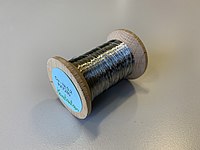
Photo from wikipedia
In this study, the thermal cyclic properties of Ti-(50-x)Pd-xPt-5Zr alloys (x = 5, 15, 25, at%), comprising B2 and B19 structures in austenite and martensite, were investigated by a thermal… Click to show full abstract
In this study, the thermal cyclic properties of Ti-(50-x)Pd-xPt-5Zr alloys (x = 5, 15, 25, at%), comprising B2 and B19 structures in austenite and martensite, were investigated by a thermal cyclic compression test under a constant load of between 15 and 200 MPa. The transformation temperature measured using differential scanning calorimetry increased with increasing Pt concentration. The highest austenite finishing (Af) temperature, 648 °C, was obtained in the Ti-25Pd-25Pt-5Zr alloy. Irrecoverable strain due to thermal cyclic testing was observed during each test, even at a stress of 50 MPa. The work output, calculated as the product of the transformation strain and the applied stress from strain–temperature curves, decreased with increasing Pt concentration. This was because of the lower strength of the austenite phase due to Af increasing with an increase in the concentration of Pt. Although irrecoverable strain was observed with the first thermal cycle test, it decreased after several thermal cyclic tests, which are called training.
Journal Title: Crystals
Year Published: 2019
Link to full text (if available)
Share on Social Media: Sign Up to like & get
recommendations!